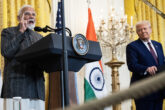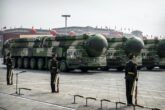October 07, 2021
Tangled Threats: Integrating U.S. Strategies toward China and North Korea
Executive Summary
China and North Korea pose intertwined challenges for U.S. and allied policy. The Korean Peninsula constitutes just one area among many in U.S.-China relations. Meanwhile, issues on the peninsula remain central to the future stability and security of Northeast Asia and implicate many broader questions about regional and global order. Dealing with China and North Korea as an interlocking pair requires integrated policies that balance the risks and rewards of various possible approaches. This policy brief explains how to develop such policies and why they are the best option for the current regional landscape.
North Korea plays several roles in China’s foreign policy. These include diverting geopolitical attention away from China, providing Beijing with an opportunity to cooperate with other states, creating a point of leverage for China to extract concessions on separate issues, and acting as a flashpoint with the potential for a regional war that directly affects China’s security. At any given time, some roles will be more pronounced than others, but each of them is always present to some degree.
Any integrated U.S. strategy toward the pair will have to account for a volatile geopolitical landscape in Northeast Asia. Major trends include closer ties between Beijing and Pyongyang, deteriorating U.S.-China relations, and South Korea’s desire, especially under the government of President Moon Jae-in, to engage North Korea while balancing ties with China and the United States.
The United States should employ a strategy toward China and North Korea that blends calibrated pressure and results-oriented engagement. The goal of this strategy should be problem-management rather than problem-solving. Washington should implement this approach across four areas: shaping U.S.-China relations regarding the Korean Peninsula; engaging North Korea on political and security issues; promoting stable deterrence in the region; and coordinating a shared inter-Korean and foreign policy with South Korea.
Key recommendations for the United States include acknowledging that major breakthroughs are unlikely with either China or North Korea; proposing four-party nuclear and peace talks with South Korea, North Korea, China, and the United States; and standing up a Nuclear Planning Group that includes Washington, Seoul, and Tokyo to bolster deterrence and stem nuclear proliferation pressures.
Introduction
Geopolitical dynamics in Northeast Asia are increasingly volatile, as U.S.-China strategic competition intensifies and tensions persist on the Korean Peninsula. Addressing issues on the Korean Peninsula constitutes just one area among many in U.S.-China relations, but challenges on the peninsula remain central to the future of Northeast Asia’s regional political and security arrangements. This reality raises the parallel questions: Where does the Korean Peninsula fit into U.S.-China strategic competition? And how will competition between Washington and Beijing affect Korean Peninsula affairs?
This policy brief explores the intersection of the China challenge and the North Korea threat and assesses the implications for U.S. national security policy. It proceeds in three parts: The paper starts by detailing the multiple strategic roles that North Korea plays in China’s foreign and security policy. It then examines the current environment in and around the Korean Peninsula with a focus on U.S. and Chinese approaches toward peace and nuclear negotiations in the context of strategic competition between the two major powers. The last section considers potential policy frameworks for approaching China and North Korea as an interlocking pair and concludes with recommendations for policymakers.
Download the Full Report
More from CNAS
-
America’s Self-Loathing Is a Losing Hand
This article was originally published in The Washington Post.Around 10 years ago, the United States began a historic shift in its grand strategy toward China, abandoning the b...
By David Feith
-
Indo-Pacific Security / Energy, Economics & Security / Technology & National Security
Selling AI Chips Won’t Keep China Hooked on U.S. TechnologyU.S. policy should not rest on the illusion that selling chips can trap China inside the American tech ecosystem....
By Janet Egan
-
Will New Delhi-Beijing Move Beyond Friction Points? | Ex-White Official On India-China Reset
Prime Minister Narendra Modi on Friday said that India and China, as two major economies, must work together to bring stability to the global economic order. NDTV's Gaurie Dwi...
By Lisa Curtis
-
How Big Will China’s Nuclear Arsenal Get?
China’s nuclear expansion is already feeding an arms race—a contest that is accelerating partly because the finish line remains unknown....
By Jacob Stokes





